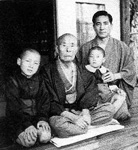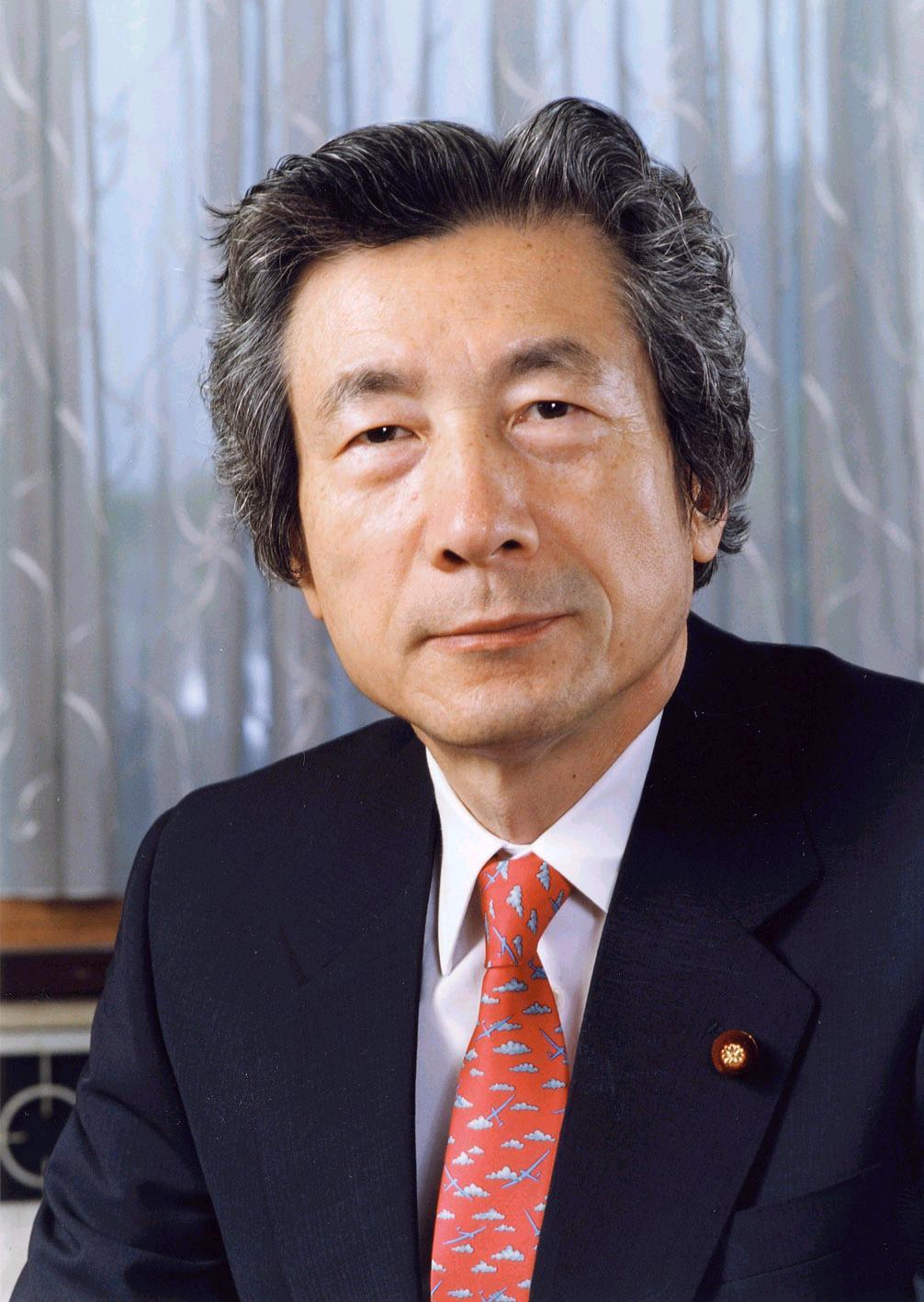
Junichiro Koizumi is a former Japanese politician who was Prime Minister of Japan and President of the Liberal Democratic Party (LDP) from 2001 to 2006. He retired from politics in 2009. He is the sixth-longest serving Prime Minister in Japanese history.

Kiichi Miyazawa was a Japanese politician who served as Prime Minister of Japan from 1991 to 1993. He was a member of the National Diet of Japan for over 50 years.

General elections were held in Japan on November 9, 2003. Incumbent Prime Minister Junichiro Koizumi of the Liberal Democrat Party won the election but with a reduced majority. The main opposition Democratic Party made considerable gains, winning 177 of the 480 seats in the House of Representatives, its largest share ever. Other traditional parties like the Communist Party and the Social Democrat Party lost a significant numbers of seats, making a two-party system a possibility in later Japanese politics.
Koizumi is a Japanese family name.

Junya Koizumi was a Japanese politician who served as Director General of the Japan Defense Agency during the 1960s.
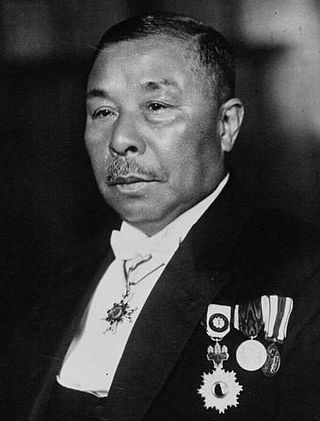
Koizumi Matajirō was a Japanese politician and cabinet minister in the Taishō period and early Shōwa period Japan. He was the grandfather of Jun'ichirō Koizumi, who served as the Prime Minister of Japan from 2001 to 2006.

Yuriko Koike is a Japanese politician who currently serves as the Governor of Tokyo since 2016. She graduated from the American University in Cairo in 1976 and was a member of the House of Representatives of Japan from 1993 until 2016, when she resigned to run for Governor of Tokyo. She also previously served as Minister of the Environment in the Junichiro Koizumi cabinet from 2003 to 2006 and briefly as Minister of Defense in the first cabinet of Shinzō Abe in 2007. Koike was elected Governor of Tokyo in 2016, becoming the metropolis's first female Governor. Koike was re-elected Governor in 2020 in a landslide, winning 59.7% of the vote.
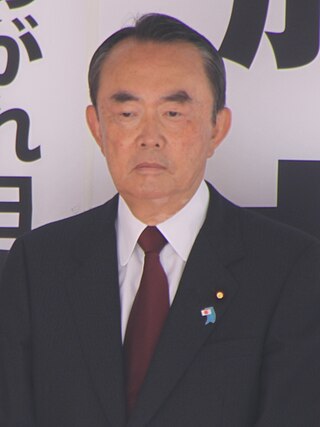
Takeo Hiranuma is a Japanese politician and a member of the House of Representatives. He is a member of the Liberal Democratic Party and is former chairperson of the Party for Future Generations.

Kenji Kosaka was a Japanese politician.
Toshihiro Nikai is a Japanese politician for the Liberal Democratic Party (LDP) and the leader of the LDP Shisuikai faction, who served as the Secretary-General of the LDP from 2016 to 2021. He was previously the Minister of Economy, Trade and Industry. Nikai is currently serving in his eighth term in the Lower House representing Wakayama's Third District. He is widely considered to be "Japan's most pro-China lawmaker". He has also been criticized for misogynistic views expressed in the past, and caused controversy when he invited women to "look, but not talk" at key party meetings.

Yasuo Fukuda is a former Japanese politician who served as Prime Minister of Japan from 2007 to 2008. He was previously the longest-serving Chief Cabinet Secretary in Japanese history, serving in that role from 2000 to 2004 under Prime Ministers Yoshirō Mori and Junichiro Koizumi. His record was surpassed by Yoshihide Suga, who served almost twice as long.

Masajuro Shiokawa was a Japanese economist and politician.

A leadership election was held in the Liberal Democratic Party of Japan on 23 September 2007 after the incumbent party leader and Prime Minister of Japan Shinzō Abe announced that he would resign on 12 September 2007. Abe had only been elected to the post slightly less than a year earlier; his resignation came only three days after a new parliamentary session had begun. Abe said his unpopularity was hindering the passage of an anti-terrorism law, involving among other things Japan's continued military presence in Afghanistan. Party officials also said the embattled Prime Minister was suffering from poor health.

Kazunori Tanaka is a Japanese politician serving in the House of Representatives in the Diet as a member of the Liberal Democratic Party and Minister of Reconstruction. A native of Toyoura District, Yamaguchi and graduate of Hosei University he was elected for the first time in 1996 after serving in local assemblies. Tanaka was elected seven times in Kanagawa, prefecture 10th district Tanaka is general director of the Liberal Democratic Party International bureau in 2015.

The controversies surrounding Yasukuni Shrine are related to the choice of Japanese people who are honoured at this nationally significant Shinto shrine and war museum in central Tokyo. Most of the venerated dead served the Emperors of Japan during wars from 1867 to 1951 but they also include civilians in service and government officials. It is the belief of Shintoism that Yasukuni enshrines the actual souls of the dead, known as kami in Japanese. The kami are honoured through liturgical texts and ritual incantations known as Norito.

Mudazumo Naki Kaikaku is a Japanese satirical mahjong manga series by Hideki Ohwada. It was initially irregularly serialized in the Kindai Mahjong Original manga magazine published by Takeshobo, then switched to bimonthly serialization on Takeshobo's other mahjong manga magazine Kindai Mahjong in April 2009. An anime adaptation was released on February 26, 2010 as an original video anime.
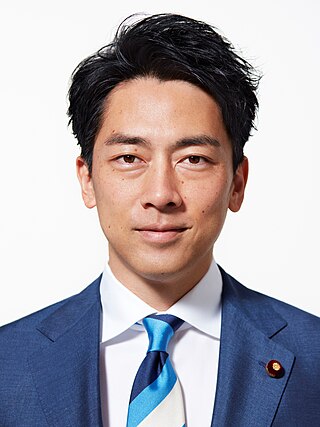
Shinjirō Koizumi is a Japanese politician who served as the Minister of the Environment from September 2019 to October 2021. He also serves as a member the Member of the House of Representatives for the Liberal Democratic Party. He is the second son of former Prime Minister Junichirō Koizumi and the younger brother of actor Kotaro Koizumi.
Jun'ichirō, Junichirō, Junichiro or Junichirou is a masculine Japanese given name. Notable people with the name include:

Toranosuke Katayama is a Japanese politician who has held multiple different cabinet posts. He is a former member of Liberal Democratic Party (LDP), and was co-president of Nippon Ishin no Kai alongside Ichirō Matsui from 2016 to 2021.
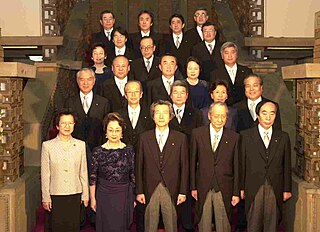
The First Koizumi Cabinet governed Japan from April 2001 until November 2003 under the leadership of Prime Minister Junichiro Koizumi, who came to power after winning a surprise victory in the LDP presidential election of 2001. The cabinet continued the LDP-Komeito-NCP coalition and contained a record number of 5 women, including Makiko Tanaka as the first female Foreign Minister. Several ministers from the previous Mori Administration remained in office to ensure the continuity and stability of government. Unusually for an LDP leader, Koizumi chose his cabinet himself and personally asked ministers to join the government, unlike previous practice where party factional leaders often chose government posts.
